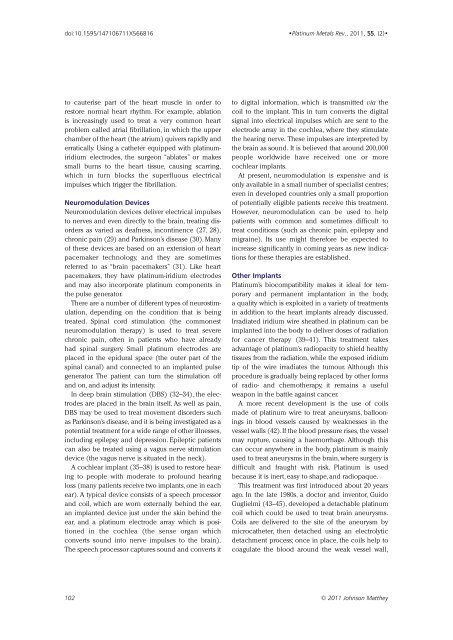Download - Platinum Metals Review
Download - Platinum Metals Review
Download - Platinum Metals Review
You also want an ePaper? Increase the reach of your titles
YUMPU automatically turns print PDFs into web optimized ePapers that Google loves.
doi:10.1595/147106711X566816<br />
•<strong>Platinum</strong> <strong>Metals</strong> Rev., 2011, 55, (2)•<br />
to cauterise part of the heart muscle in order to<br />
restore normal heart rhythm. For example, ablation<br />
is increasingly used to treat a very common heart<br />
problem called atrial fibrillation, in which the upper<br />
chamber of the heart (the atrium) quivers rapidly and<br />
erratically. Using a catheter equipped with platinumiridium<br />
electrodes, the surgeon “ablates” or makes<br />
small burns to the heart tissue, causing scarring,<br />
which in turn blocks the superfluous electrical<br />
impulses which trigger the fibrillation.<br />
Neuromodulation Devices<br />
Neuromodulation devices deliver electrical impulses<br />
to nerves and even directly to the brain, treating disorders<br />
as varied as deafness, incontinence (27, 28),<br />
chronic pain (29) and Parkinson’s disease (30). Many<br />
of these devices are based on an extension of heart<br />
pacemaker technology, and they are sometimes<br />
referred to as “brain pacemakers” (31). Like heart<br />
pacemakers, they have platinum-iridium electrodes<br />
and may also incorporate platinum components in<br />
the pulse generator.<br />
There are a number of different types of neurostimulation,<br />
depending on the condition that is being<br />
treated. Spinal cord stimulation (the commonest<br />
neuromodulation therapy) is used to treat severe<br />
chronic pain, often in patients who have already<br />
had spinal surgery. Small platinum electrodes are<br />
placed in the epidural space (the outer part of the<br />
spinal canal) and connected to an implanted pulse<br />
generator. The patient can turn the stimulation off<br />
and on, and adjust its intensity.<br />
In deep brain stimulation (DBS) (32–34), the electrodes<br />
are placed in the brain itself. As well as pain,<br />
DBS may be used to treat movement disorders such<br />
as Parkinson’s disease, and it is being investigated as a<br />
potential treatment for a wide range of other illnesses,<br />
including epilepsy and depression. Epileptic patients<br />
can also be treated using a vagus nerve stimulation<br />
device (the vagus nerve is situated in the neck).<br />
A cochlear implant (35–38) is used to restore hearing<br />
to people with moderate to profound hearing<br />
loss (many patients receive two implants, one in each<br />
ear). A typical device consists of a speech processor<br />
and coil, which are worn externally behind the ear,<br />
an implanted device just under the skin behind the<br />
ear, and a platinum electrode array which is positioned<br />
in the cochlea (the sense organ which<br />
converts sound into nerve impulses to the brain).<br />
The speech processor captures sound and converts it<br />
to digital information, which is transmitted via the<br />
coil to the implant. This in turn converts the digital<br />
signal into electrical impulses which are sent to the<br />
electrode array in the cochlea, where they stimulate<br />
the hearing nerve. These impulses are interpreted by<br />
the brain as sound. It is believed that around 200,000<br />
people worldwide have received one or more<br />
cochlear implants.<br />
At present, neuromodulation is expensive and is<br />
only available in a small number of specialist centres;<br />
even in developed countries only a small proportion<br />
of potentially eligible patients receive this treatment.<br />
However, neuromodulation can be used to help<br />
patients with common and sometimes difficult to<br />
treat conditions (such as chronic pain, epilepsy and<br />
migraine). Its use might therefore be expected to<br />
increase significantly in coming years as new indications<br />
for these therapies are established.<br />
Other Implants<br />
<strong>Platinum</strong>’s biocompatibility makes it ideal for temporary<br />
and permanent implantation in the body,<br />
a quality which is exploited in a variety of treatments<br />
in addition to the heart implants already discussed.<br />
Irradiated iridium wire sheathed in platinum can be<br />
implanted into the body to deliver doses of radiation<br />
for cancer therapy (39–41). This treatment takes<br />
advantage of platinum’s radiopacity to shield healthy<br />
tissues from the radiation, while the exposed iridium<br />
tip of the wire irradiates the tumour. Although this<br />
procedure is gradually being replaced by other forms<br />
of radio- and chemotherapy, it remains a useful<br />
weapon in the battle against cancer.<br />
A more recent development is the use of coils<br />
made of platinum wire to treat aneurysms, balloonings<br />
in blood vessels caused by weaknesses in the<br />
vessel walls (42).If the blood pressure rises, the vessel<br />
may rupture, causing a haemorrhage. Although this<br />
can occur anywhere in the body, platinum is mainly<br />
used to treat aneurysms in the brain,where surgery is<br />
difficult and fraught with risk. <strong>Platinum</strong> is used<br />
because it is inert, easy to shape, and radiopaque.<br />
This treatment was first introduced about 20 years<br />
ago. In the late 1980s, a doctor and inventor, Guido<br />
Guglielmi (43–45), developed a detachable platinum<br />
coil which could be used to treat brain aneurysms.<br />
Coils are delivered to the site of the aneurysm by<br />
microcatheter, then detached using an electrolytic<br />
detachment process; once in place, the coils help to<br />
coagulate the blood around the weak vessel wall,<br />
102 © 2011 Johnson Matthey
















